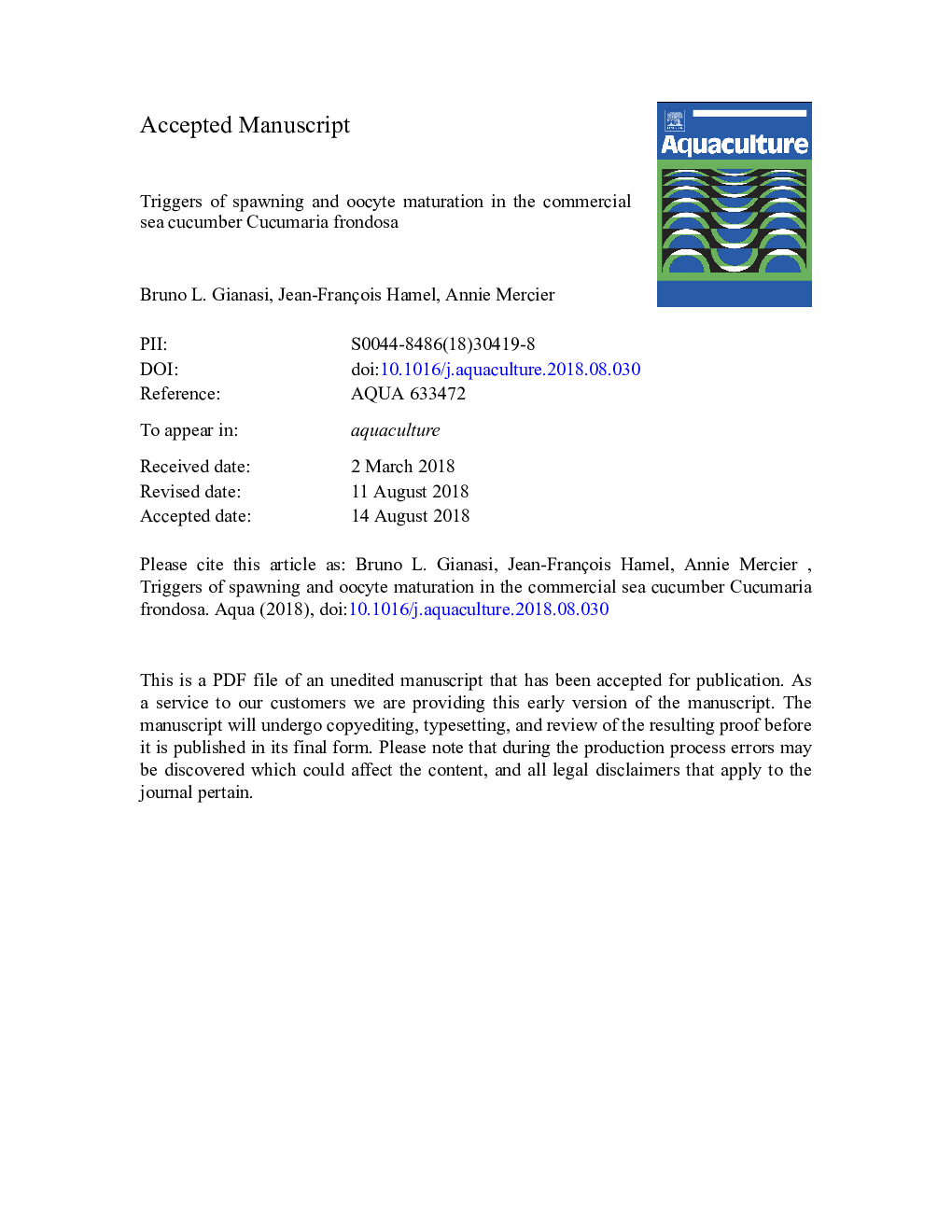| کد مقاله | کد نشریه | سال انتشار | مقاله انگلیسی | نسخه تمام متن |
|---|---|---|---|---|
| 8950022 | 1645731 | 2019 | 43 صفحه PDF | دانلود رایگان |
عنوان انگلیسی مقاله ISI
Triggers of spawning and oocyte maturation in the commercial sea cucumber Cucumaria frondosa
دانلود مقاله + سفارش ترجمه
دانلود مقاله ISI انگلیسی
رایگان برای ایرانیان
کلمات کلیدی
موضوعات مرتبط
علوم زیستی و بیوفناوری
علوم کشاورزی و بیولوژیک
علوم آبزیان
پیش نمایش صفحه اول مقاله

چکیده انگلیسی
The present study investigated methods to trigger spawning and artificially induce oocyte maturation in the commercial cold-water suspension-feeding sea cucumber Cucumaria frondosa. Spawning occurred after exposure to live phytoplankton, commercial phytoplankton paste, and conspecific sperm. Live phytoplankton at 1â¯Ãâ¯105 cells mlâ1 induced the highest proportion of females to spawn (mean of 56%); promoted the greatest oocyte release (mean of 19,200 oocytes femaleâ1), best quality of eggs and highest survival of embryos (65%; 20 d post fertilization). More concentrated live phytoplankton (1â¯Ãâ¯106 cells mlâ1) triggered 43% of the females to release ~16,100 oocytes femaleâ1 and survival rates 20 d post fertilization were lower (50%). Both phytoplankton paste treatments (1â¯Ãâ¯105 and 1â¯Ãâ¯106 cells mlâ1) yielded intermediate results in terms of percent spawning females (26%), abundance of oocytes released (11,000 and 7300 oocytes femaleâ1, respectively), quality of eggs, and survival of embryos (44 and 50%, respectively). Sperm from conspecific (2 and 10â¯Ãâ¯106 spermatozoa mlâ1) induced the lowest proportion of females to spawn (16%) with release of 3000 and 1700 oocytes femaleâ1, respectively; furthermore, all embryos died within 10 d post fertilization. Results for males were slightly different: spawning was more frequent (63%) in the sperm treatment at 2â¯Ãâ¯106 spermatozoa mlâ1 followed by live phytoplankton at 1â¯Ãâ¯106 and 1â¯Ãâ¯105 cells mlâ1 (43%), and phytoplankton paste at 1â¯Ãâ¯105 cells mlâ1 (46%); the lowest spawning success was observed for phytoplankton paste at 1â¯Ãâ¯106 cells mlâ1 and conspecific sperm at 10â¯Ãâ¯106 spermatozoa mlâ1 (26%). Thermal shock, desiccation, potassium chloride (injection or bath), and serotonin (injection) did not induce spawning in C. frondosa. When oocytes isolated from mature ovaries were exposed to three different concentrations of 1-Methyladenine (1-MA), Dithiothreitol (DTT), 2,3-Dimercapto-1-propanol (BAL), and L-cysteine (L-cyst), DTT at 10â1â¯M induced the highest proportion of oocytes (48%) to shed follicle cells (i.e. ovulate); whereas other treatments induced only 2-6% of ovulation, similar to the control (seawater). All oocytes that shed follicle cells remained unfertilizable. Overall, live phytoplankton emerged as the most suitable spawning trigger for C. frondosa, a Dendrochirotida that produces maternally-provisioned oocytes. In the context of expanding sea cucumber aquaculture, this finding provides a tool to maximize the availability of gametes in this cold-water species, with possible applicability to similar commercial dendrochitotids.
ناشر
Database: Elsevier - ScienceDirect (ساینس دایرکت)
Journal: Aquaculture - Volume 498, 1 January 2019, Pages 50-60
Journal: Aquaculture - Volume 498, 1 January 2019, Pages 50-60
نویسندگان
Bruno L. Gianasi, Jean-François Hamel, Annie Mercier,